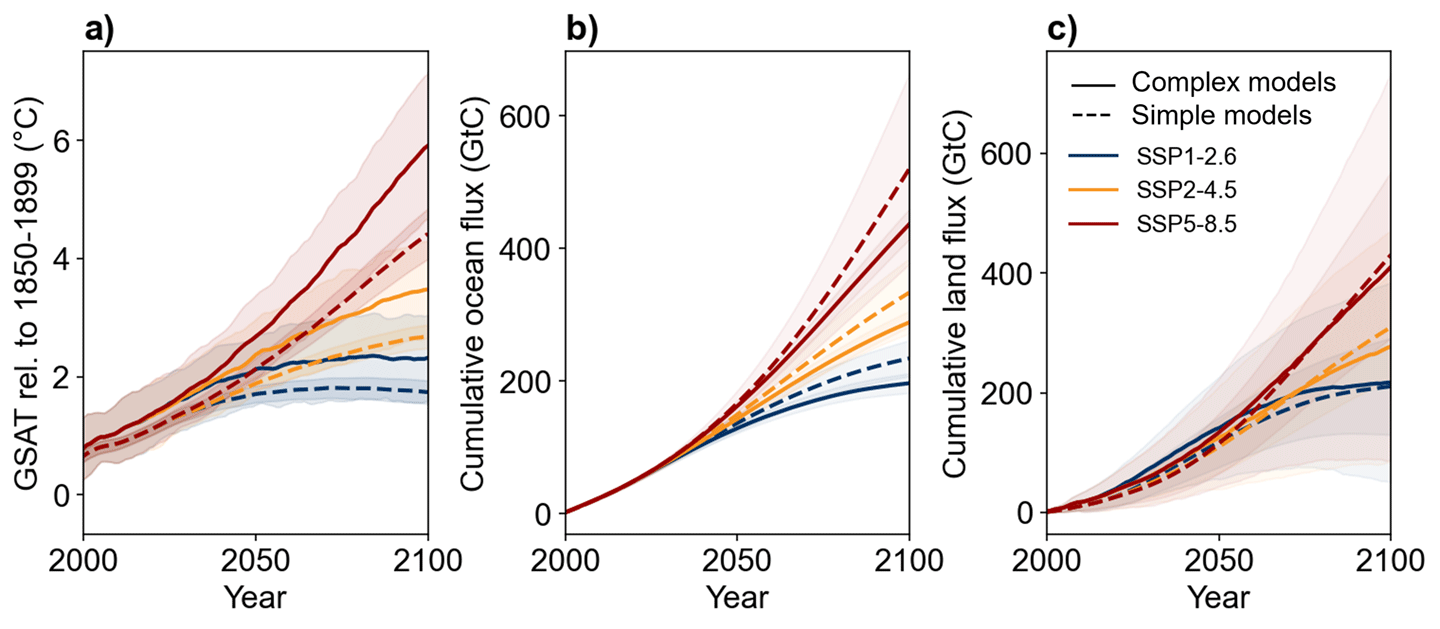Recent Research Results Do complex and simple models agree on the carbon cycle projections?
The shared socioeconomic pathways (SSPs) are roadmaps of how our world might change in the future. They are created using integrated assessment models that project how our societies might change based on possible future developments of the economy and society. To understand the future changes of the Earth system under global warming, two other types of models are often used – state-of-the-art complex Earth system models and simple climate models, also known as climate emulators. These models utilize future greenhouse gas emissions or concentrations as inputs, which are adapted from integrated assessment models. They simulate the response of future climate and carbon cycle. Simple climate models can be used to analyze a larger set of future scenarios because complex models are more expensive to run and require supercomputers. However, how consistent are simple models with complex models?

In this study, we compared carbon cycle projections using complex and simple models to investigate their consistency under past climate and future SSPs. First, we compared how well the models simulated the past carbon cycle against historical observations. Then, we evaluated their future carbon cycle projections under selected SSPs, including the 'sustainability' SSP1-2.6, 'middle of the road' SSP2-4.5, and 'fossil fuel development' SSP5-8.5 scenarios (see Figure 1). We found that compared to simple models, complex models estimate larger temperature increase but a smaller ocean carbon sink in the historical period and future SSPs. In addition, models give varying estimates of historical and future land carbon sink.
Next, we compared the models' carbon cycle responses to future changes in the global carbon dioxide concentration and temperature (see Figure 2). Based on our evaluation, we suggest improvements to the models to make their carbon cycle projections more consistent with each other if the purpose of simple models is to emulate the behaviors of complex models.

Simple models are usually calibrated to match historical observations. But this can make them less reliable for scenarios with high emissions or more complex scenarios with periods of increasing and decreasing carbon emissions. Figure 2 shows that simple models project less saturation of the carbon flux increase at high CO2 concentrations compared to complex models. This may be because simple models do not account for the decrease in plants' ability to take up carbon when CO2 levels are high, through nutrients limitation, or due to high temperatures over the land. Furthermore, simple models simulate that carbon moves from the surface to the deep ocean faster than complex models. This is apparent in a larger hysteresis of ocean carbon flux to the changes in CO2 and temperature (Figures 1b and 2a, c).
Complex models project a future land carbon sink with a large inter-model difference (see shading of Figures 1c, 2). They do not agree on how land-use change emissions are calculated and how they affect the carbon cycle. Besides, complex models show a large difference in the carbon cycle response to increased temperatures. The response varies between warm tropical regions, where more warming may cause greater ecosystem stress, and cold northern regions, where more warming may lead to a longer plant growing period.
To improve the alignment of carbon cycle projections between complex and simple models, we recommend the following areas for model development: (1) the mixing of carbon from the surface to the deep ocean, especially for the simple models; (2) the future carbon cycle response to changes in carbon dioxide and temperature for complex and simple models; (3) the representation of land-use change emissions in the complex and simple models; and (4) calibration of simple models to a wider range of scenarios. Improving the carbon cycle features of complex and simple models will increase their usefulness for climate and carbon cycle research.
Assessing carbon cycle projections from complex and simple models under SSP scenarios
Authors: Melnikova, I., Ciais, P., Boucher, O. & Tanaka, K.
Journal: Climatic Change 176, 168 (2023)
https://doi.org/10.1007/s10584-023-03639-5

